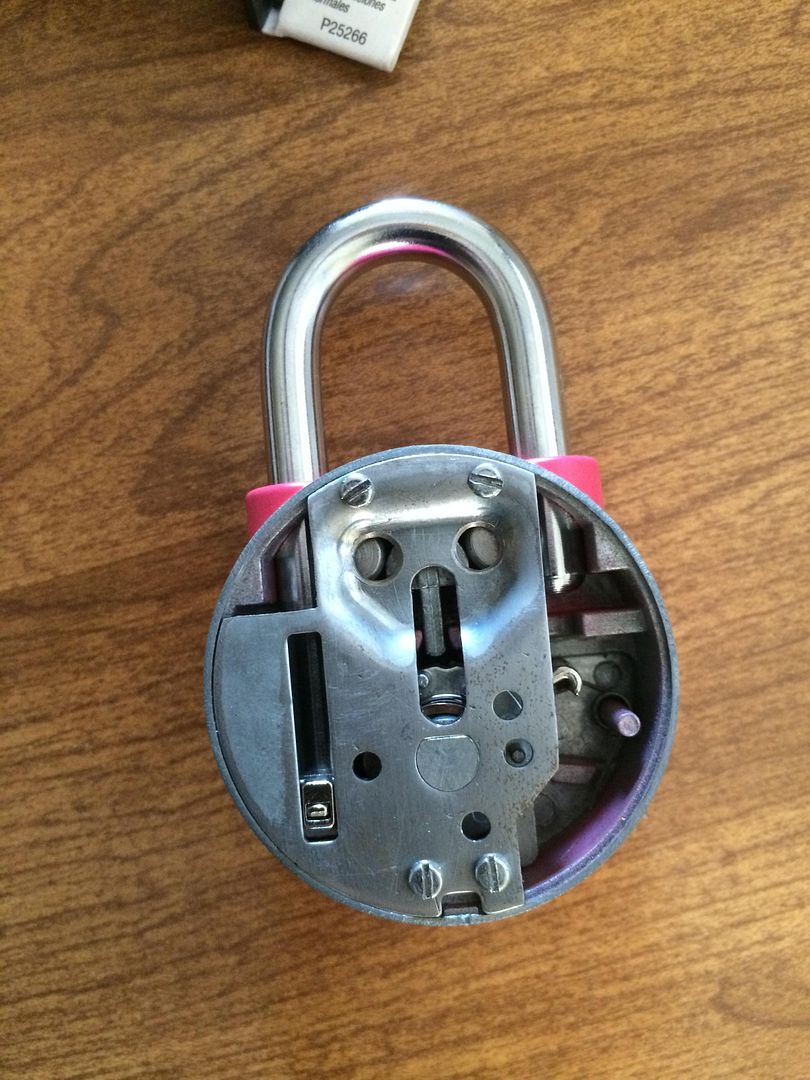Hello again!
Motivated again by Gordon's "What Is Inside an S&G 6730 Safe Lock?" post (https://www.lockpicking101.com/viewtopic.php?f=36&t=62460) I wanted to share my study of a Master-brand combination padlock I had lying around.


The lock is/was otherwise quite sturdy, but the backplate was very easy to force open with a small scredriver. (I opened it a long time ago, so I can't quite remember all of the details, but if I recall correctly it felt more like being stamped than welded close.) Behind the backplate is a thicker piece of metal that has a groove for the latch mechanism to run and a hole for the wheel stack to anchor in. Not quite sure what the meaning of the smaller holes was. Once the thin backplate is removed, this piece was just lifted out.


Behind the backplate we can see the dial mechanism in all of its glory. On the left we have the mechanism in a locked-position. On the right the right combination has been entered and the gates of the three wheels have aligned for the fence above to slide in. Another difference between the two pictures is the removal of a copper-colored spring from the top of the wheel-stack. This pushes the stack away from the back and towards the dial, this is a part of the mechanism to change the combination. (We'll get back to this later.)


When the right combination is entered, pulling up the shacle pushes down the fence into the aligned gates of the wheels. Note that the movement is transmitted through a pair of metal cylinders - the shacle pushes the cylinders in via the angle in the grooves, and the cylinders push the fence down via the slanted triangular shape of the upper part of the fence. The two immediate consequences of this mechanism are that
[list=]
[*] The lock can't be shimmied open.
[*] A strong force on the shackle induces only a weak force to the fence. I could keep the fence in place with one finger while using my other arm to pull on the shackle. This means that trying to pry the lock open with force is not trivial.
[/list]


At this point the whole wheel stack can be just lifted out of the lock. Beneath we see a small metal plate that keeps the recombination-lever from affecting the wheels, and underneath the lever. On the second picture the piece has been lifted on top of the fence, and you can see wedges in the lever-piece with corresponding slanted dents in the bottom. This is how turning of the lever lifts the wheel stack. In the circular hole in the bottom you can also just see two teeth of a gear at 12 o'clok, these are attached to the dial in front.


The removed wheel stack looks like this. It has a core and three identical wheels with a gate on the outer rim and a serrated interior side. Between each is a metal plate to stop the wheels from affecting each other's positions directly.


The 'core' of the wheel stack contains most of the magic of the lock. The lowes part is attached to the dial and spins with it, above it we have two free-spinning disks with several bumps on the outsides. As you might guess the outsides latch on to the serrated interiors of the wheels of the lock. on the upper and lower sides of the disks you can see the flys of the lock. The function of these is to make the second wheel turn after turning the dial for a full round, and the third wheel turn after two full rounds of the dial.

The core is also slightly extendable. This enables to give the lock a new combination: While the lock is in the open position, the fence keeps the wheels in a fixed position. Then the lever is pushed, raising the core of the wheelstack and decoupling the core of the stack from the wheels. A new combination is entered, which aligns the core of the stack to the new combination. Finally the lever is released, recoupling the core of the wheelstack to the wheels themselves.


I haven't been able to pick such a lock, yet, but I wouldn't use them for anything valuable as the back can be popped out with a two dollar screwdriver in ten seconds





